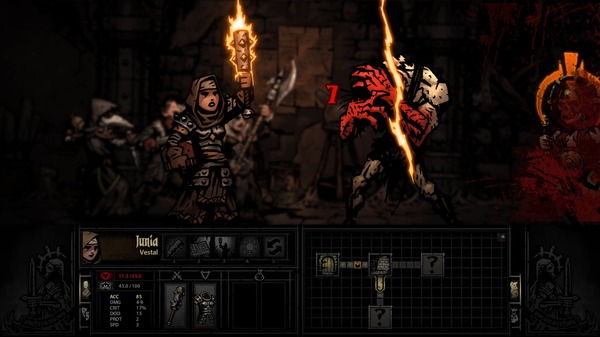A Burnt Torch: Darkest Dungeon, Mental Health and Lovecraftian Horror
A couple of hours into playing Darkest Dungeon, I started to feel like a real ass: See, I really should’ve sent Fitzroy—a mace wielding, holy word shouting “Vestal”—to the hospital because she had a bad case of tetanus. Fitzroy wound up with that tetanus because, after spending the last thirty minutes heroically bashing cultists and stitching together the wounds of her allies, I’d ordered her to open up a rusty torture device. I did this because I thought there was a chance that there might be some treasure inside it.
Um. There wasn’t. There was just tetanus.
But instead of sending her to the hospital (well, “the sanitarium”), where she could get that tetanus treated, I gave her a pouch of coins and sent her to the bar. Now just wait a second, hear me out: It turns out that getting tetanus (and combatting the skeletal hordes) is really stressful. And since I wanted Fitzroy ready to face the dreaded Bone Necromancer, I needed to keep her stress in check. If I didn’t, then she could break down at the most inopportune moment. So, the bar it is. A little lockjaw can wait.
Darkest Dungeon is a tactical, party-based roguelike with a Lovecraftian flair. You play as the last heir of a fallen noble house. It’s your job to recruit and command a set of heroes, sending them into the decrepit bowels of a ruined estate—and the corrupt environs surrounding it. There’s a lot to like here. Darkest Dungeon’s aesthetic (including its use of a Bastion-style narrator) is stunning, and it contributes to the spring-like, tense-and-release feeling of the game’s turn based, positional combat. The adventuring slots nicely into a simple, yet fulfilling town-upgrade system, which itself fits together with a unique take on character advancement. And it all hinges on managing the stress of your heroes.
It would be easy to fumble an analysis of Darkest Dungeon’s “stress” mechanics. I could pretend that it’s wholly novel, ignoring the history of meters and charts that reflect the mental state of protagonists both digital and analog. Alternatively, I could act like this was just another “sanity meter,” one more simple interpretation of the Lovecraftian trope of “madness.” But Darkest Dungeon’s latticed systems of “stress,” “quirks,” “afflictions,” and treatment go beyond the conventional depiction of “madness.” The result is something critical and frightening.
Patent US6935954 – Sanity system for video game
It’s worth understanding the backdrop that Darkest Dungeon exists against. The sanity meter has been in games in some form or another for decades now, but I wouldn’t be surprised if Eternal Darkness was the game that jumped to mind at the mention of the phrase. Frankly, it’s a game I hope we can finally stop praising.
Okay, that might be harsh: the developers at Silicon Knights deserve credit for weaving together a non-linear, intercontinental story in a genre that had previously been content with haunted houses and small towns. Playing as Alexandra Roivas, you’re tasked with investigating a mansion filled with mysterious artifacts and occult books, each of which transports you into the life of another character in a millennia-spanning story of Old Gods, romance, and betrayal. But it’s the patented (no, really) sanity meter that made Eternal Darkness famous, and a decade of distance reveals it to be a lot less interesting (and a lot more problematic) than it may have first seemed.
Whenever Alexandra (or any of the other playable characters in Eternal Darkness) is seen by a monster, their sanity meter decreases. And as “the character’s sanity level decreases,” reads the patent, “game play is effected [sic] such as by controlling game effects, audio effects, creating hallucinations and the like.” There are dozens of these. As you step into a new room, you could hear a distant scream, or notice blood dripping down the walls. Some of these effects break the fourth wall, surprising you with a message congratulating you on completing the game’s demo, or tricking you by feigning an error screen. A moment or two later, regular gameplay continues.
These sanity effects are structurally more like pranks than interrogations of mental health. (And let’s be clear, Eternal Darkness takes itself very seriously in every other way.) They are not a smart interpolation of Lovecraftian convention, they’re a novelty. And like all novelties, once you understand how the system works, the sanity meter loses a lot of its allure.
Eternal Darkness is not alone, of course. If you can put up with the occasional bit of ableist language, check this list of media with sanity meters and you’ll see a lot of common design. Most of these meters have a single axis, with sanity on one side and insanity on the other. Maxing out the meter (that is, “going insane,”) tends to result in a predictably bad outcome: You lose control of your character, or get the bad ending, or die (either directly or indirectly). In many cases, the “sanity effect” is a single instance, not a long term condition, and rarely relevant to the specifics of the character or their experiences. The few games that do treat mental health as a long-term concern have other problems. Rogue Legacy, for instance, includes a number of psychological disorders in its genetic “traits” system, but these are played for laughs. If you choose a character with dementia, the trait description reads “You are insane!” Great.
-

-

-

-

-

-

-

-

-

-

-

-

-

-

-

-

-

-

-

-

-

-

-

-

-

-

-

-

-

-

-

-

-

-

-

-

-

-

-

-









































